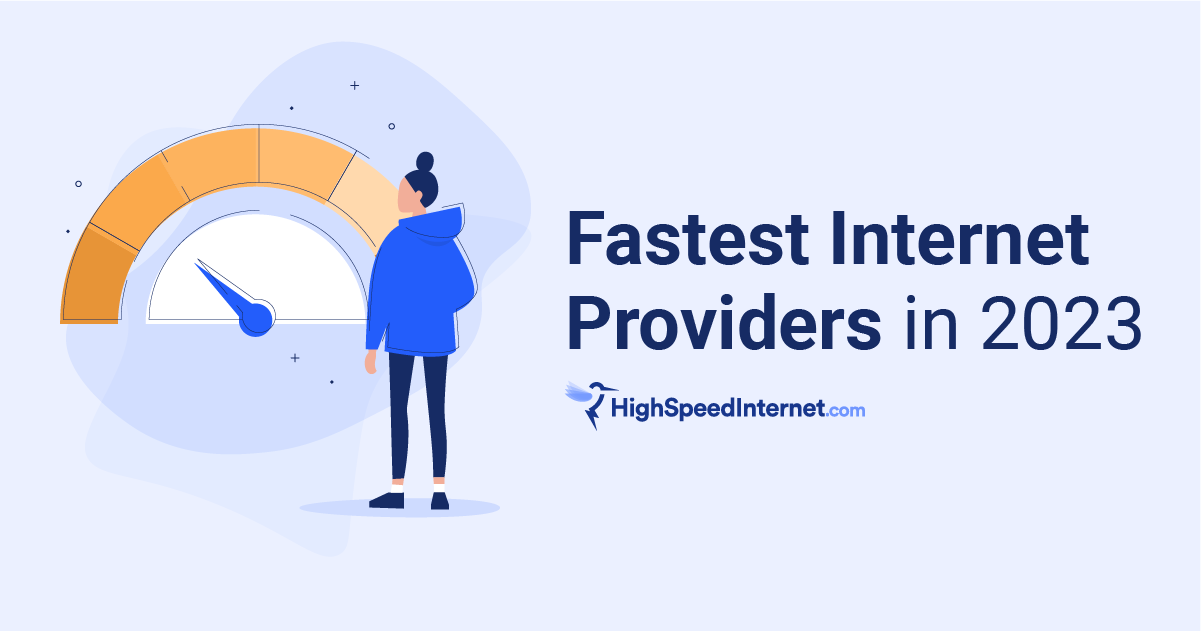The Fastest Internet Providers in 2024
ISP speed data favors accessibility over tech
Apr 5, 2024 | Share
Brand Guides, Featured, Industry Exclusive/Entertainment, Internet Speed Guides
Each year, we gauge internet service provider (ISP) performance using millions of results from the HighSpeedInternet.com speed test. This year’s data highlights that an ISP’s low and mid-tier plans often have a much bigger impact than top-tier offerings with less accessibility.
Because most major providers now offer gigabit speeds, most highly-populated areas in the U.S. have access to faster plans than anyone really needs. Regardless, many ISPs keep pushing even faster speeds with hefty infrastructure that limits these plans to select areas. Our 2024 data doesn’t favor such selective improvements.
But not all providers are chasing new tech and multi-gigabit headlines. Instead, some are choosing to focus on improving the bottom half of their plan rosters, which brings decent speeds to more people. This is how 2024’s fastest ISP rose to the top.
Fastest internet service provider: Cox

* Data from HighSpeedInternet.com Speed Test
Cox is the nation’s fastest ISP according to over 7 million speed test results. Cox customers received the fastest average download speed, coming in above its cable competitors, Xfinity and Spectrum, and even inching above premium fiber provider Google Fiber.
While Cox does offer fast multi-gigabit plans, there are faster plans out there. Google Fiber, for example, has speeds up to 8,000Mbps (8Gbps). AT&T and Ziply Fiber also offer plans at 5,000Mbps (5Gbps) and 10,000Mbps (10Gbps) respectively. So, why aren’t the fiber speed demons at the top? Because most people don’t purchase those plans. Achieving the fastest national speeds isn’t about pushing your network to the limit chasing the fastest max speeds; it’s about providing decent internet speeds to the most customers—and that’s exactly what Cox prioritized in 2023.
In June 2023, Cox delivered a big speed boost to the majority of its residential customers. Subscribers on the ISP’s most popular internet plan, Cox Go Even Faster, saw their speeds doubled from 250Mbps to 500Mbps. Those on the next tier down (Cox Go Faster) received a 100Mbps speed increase for a total of 250Mbps. The upgrade boosted the speeds of more than 75% of Cox’s residential customers.
“Last year, we doubled speeds for the majority of our customers and now deliver 500Mbps (half gig) or faster downloads to nearly 70% of our customers nationwide,” says Cox.
The 2023 upgrades were preceded by another in March 2022 that gave the brand’s most popular tier a speed jump of over 66% from 150Mbps to 250Mbps. Free speed upgrades appear to be a fixed strategy of Cox’s.
“I like how fast my service is and that there [are] no problems or interruptions.”
– Cox Customer | HSI Annual Customer Satisfaction Survey
Despite achieving the fastest average speeds in the nation, Cox doesn’t appear to have the same 10G fever as other big cable ISPs, like Xfinity and Spectrum. Sure, the brand formally “committed to 10G” in 2022, but since then we haven’t heard of any successful DOCSIS 4.0 testing or heard any news about a Cox DOCSIS 4.0 capable gateway, both of which would be necessary for Cox to make the same technological strides as it’s big cable competitors.
In contrast, as far back as 2022, Charter announced successful DOCSIS 4.0 testing that reached incredible 8.5GBps download speeds with 6Gbps upload speeds, near the max of the highest 10G expectations. Xfinity, who is largely leading the charge into 10G, has its shiny new XB10 DOCSIS 4.0 gateways delivering multi-gigabit symmetrical speeds to customers right now. However, the reality is that these cutting-edge capabilities don’t reach the majority of customers and don’t have nearly as much impact as Cox’s free speed upgrades.
Cox utilizing a different strategy doesn’t mean it isn’t constantly improving its networks. Over the last decade, the ISP has invested over 11 billion dollars in network improvements, expansions, and upgrades, Cox told HSI. In 2022, Cox committed to spending over 400 million dollars towards closing the digital divide by expanding its reach to underserved and rural communities.
We asked representatives from Cox what the ISP’s plans were going forward, and while they didn’t give much detail, they did reveal there are plans for more multi-billion dollar annual infrastructure investments for the next several years.
Cox’s success suggests that achieving the fastest speeds in the nation is not about chasing the latest tech, making headlines in the cable 10G arms race, or delivering another absurdly fast gigabit offering. We already have the means to deliver excellent connectivity to the majority of households. The recipe for achieving the fastest speeds depends on making the speeds we already have accessible to as many people as possible.
Methodology
When customers think of internet speed and when ISPs advertise internet speed, both are focused on download speed. This is for good reason, as download speed has the potential to make or break your online experience more than any other performance metric. That’s why HighSpeedInternet.com ranks its fastest ISPs by average download speed, provided each provider meets certain thresholds for upload speed and latency.
Other measurements, like upload speed, latency, and jitter, are important; but unlike download speed, it doesn’t make sense to scrutinize these measurements beyond checking they reach an acceptable threshold. If your ISP doubled your upload speed or halved your latency, you likely wouldn’t even notice. But doubling download speed could have a profound effect on your overall experience.
Many ISP speed scoring systems use a combination of download speed and upload speed, but this creates a situation where the ISP with the fastest download speed may not be on top, and we don’t think that’s what customers are looking for in a speed analysis, provided the fastest ISP delivers enough upload speed and low enough latency to create a seamless experience.
We also aggregate tests we determine to be from the same household, giving each customer and connection the same weight in our analysis. Lastly, we use filters to improve accuracy and limit the influence of outliers. All providers are subject to the same analysis parameters.
Author - Austin Aguirre
Austin worked as a broadband technician installing and troubleshooting countless home internet networks for some of the largest ISPs in the U.S. He became a freelance writer in 2020 specializing in software guides. After graduating with a BS in technical communication from Arizona State University, he joined the team at HighSpeedInternet.com where he focuses on home network improvement and troubleshooting.
Editor - Jessica Brooksby
Jessica loves bringing her passion for the written word and her love of tech into one space at HighSpeedInternet.com. She works with the team’s writers to revise strong, user-focused content so every reader can find the tech that works for them. Jessica has a bachelor’s degree in English from Utah Valley University and seven years of creative and editorial experience. Outside of work, she spends her time gaming, reading, painting, and buying an excessive amount of Legend of Zelda merchandise.




